June 23, 2025 – Site Visit for School for Female Monastic Practitioners and MOU Signing
Hello. Today, Sunim visited the site of a future school for female monastic practitioners (nuns) and traveled to Thimphu to sign a Memorandum of Understanding(MOU) with the Cabinet Minister of Bhutan.
At 5:45 AM, Sunim had a cup of tea at the accommodation and set out to visit the site for the school for female monastic practitioners. After a 5-minute drive to the location, villagers had set up a Bhutanese-style tent and were waiting for Sunim with incense burning.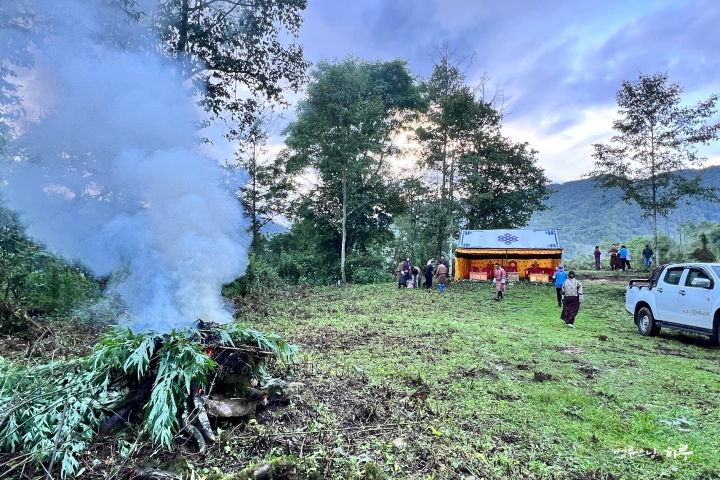
After slowly touring the site, Sunim spoke with Dr. Tashi, the Secretary-General of the Bhutan Bhikkhuni Foundation.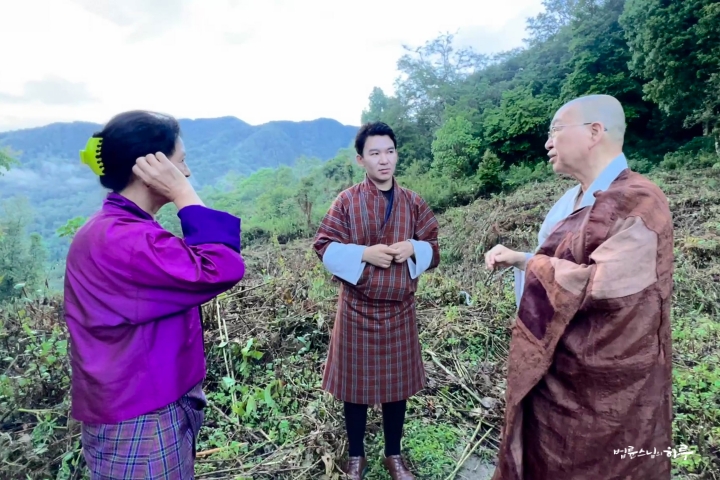
“Building a school in such a deep mountain area will incur high transportation costs for materials. When constructing small buildings, cheaper land is advantageous, but as the scale increases, land costs become a smaller portion of the total construction budget.”
“I was thinking of a place where both meditation and study could be done together.”
“That’s a traditional way of thinking. For a school for women’s education, it should be convenient for teachers to come, and basic facilities like electricity and water should be available.”
“I wanted to teach up to higher education while keeping Buddha’s teachings at the center.”
“This place could be meaningful for local residents, but if we’re building a school for female monastic practitioners for all of Bhutan, areas near cities like Paro, Punakha, or Gelephu would be more suitable. This place would suit about 20 traditional practitioners to study, but it would be difficult for higher education. For higher education, we need qualified teachers for subjects like math, science, and social studies. Being close to the city makes it easier to find volunteers too. Though the scenery and mild climate make it ideal for meditation, it would present many challenges as an educational institution. Considering not just the women’s educational institution but also future operations like nursing homes or care hospitals, a location not too far from the city center would be more advantageous.
I also once built a retreat center in the mountains in Korea because the land was cheap. But when we actually operated it, the construction costs were much higher. And with many people coming and going, transportation costs were high too.”
“Yes, the residents here also want a space for meditation.”
Sunim then carefully checked the climate conditions of the area, including where the drinking water comes from, how cold it gets in winter, and whether leaves fall in autumn.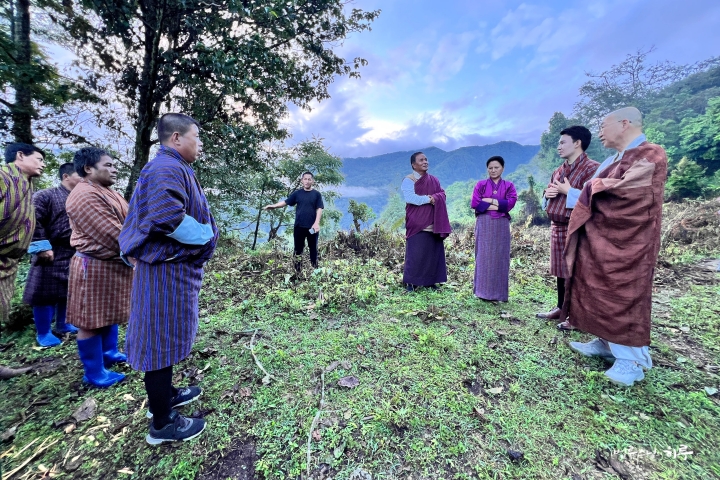
After sharing tea prepared by the residents, Sunim presented a donation to them.
“Please use this to help prepare the site.” 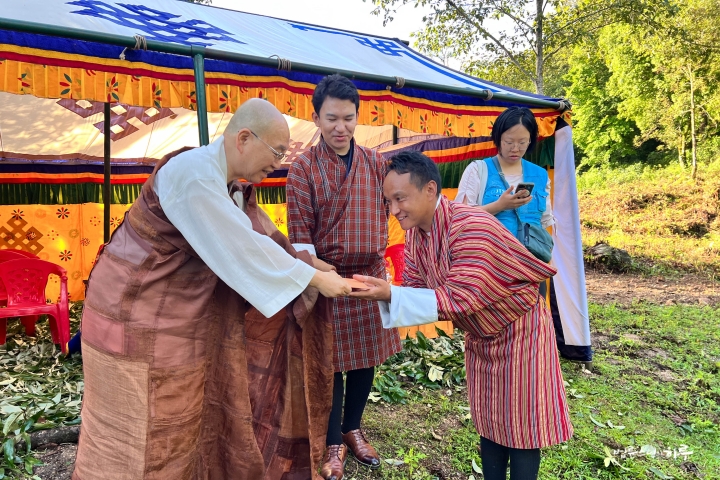
Returning to the accommodation for breakfast, Sunim presented gifts of gratitude to the host couple and departed for Thimphu at 7:15 AM.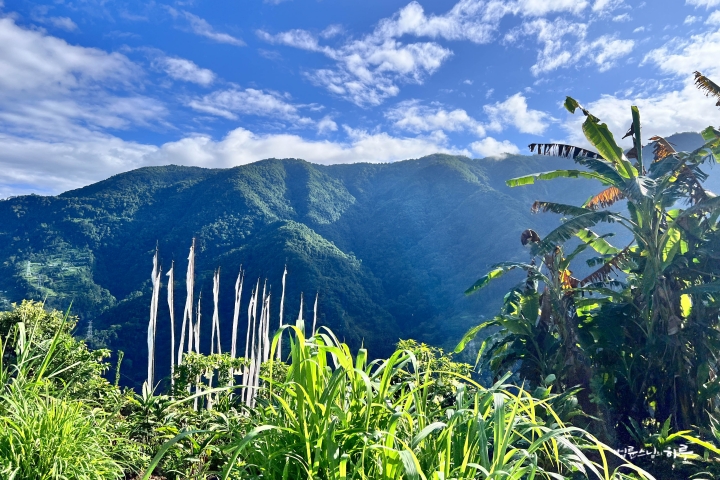
At 11 AM, they briefly stopped at Lobesa on the way to Punakha to rest and have a cup of tea.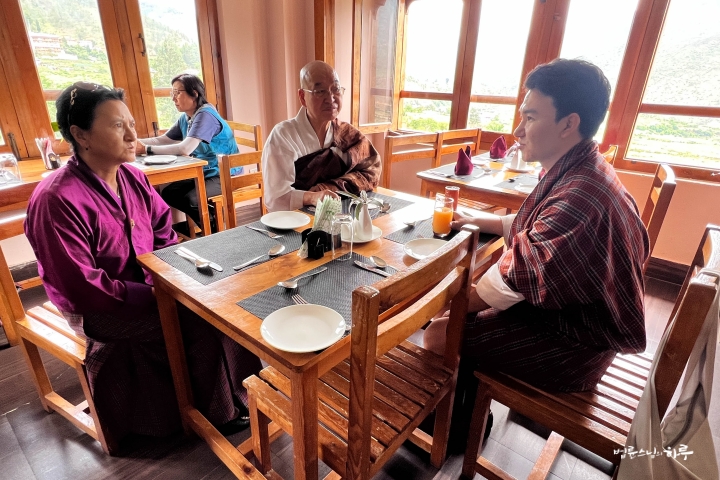
They arrived in Thimphu just before 1 PM. As it was lunchtime, Rinchen, who was serving as interpreter, wanted to introduce Sunim to delicious Bhutanese dumplings called “momos” and guided him to a restaurant. Finding the fork uncomfortable, Sunim took out chopsticks from his bag.
“I brought these chopsticks from the airplane. I always carry them to use, but I rarely get the chance, so the paper has gotten a bit worn.” 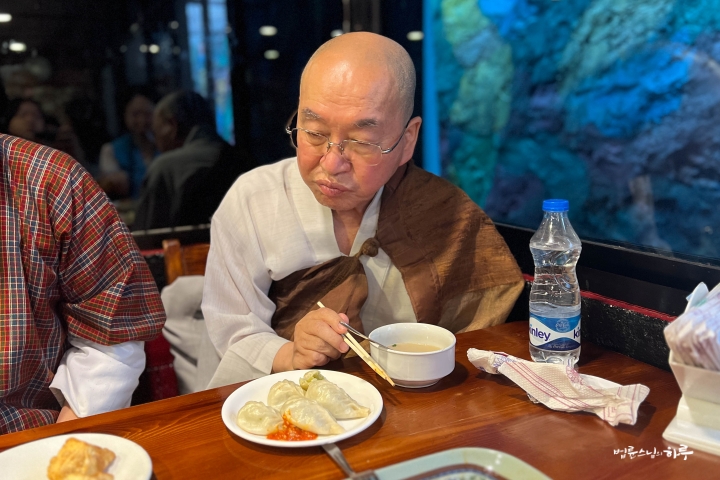
After finishing the meal, at 2 PM, they arrived at today’s accommodation, Rinchen’s house. Sunim presented a gift to the driver who had been with them for the past week, expressing his gratitude.
“Thank you for all your hard work driving. Yesterday especially, you drove for a long time.” 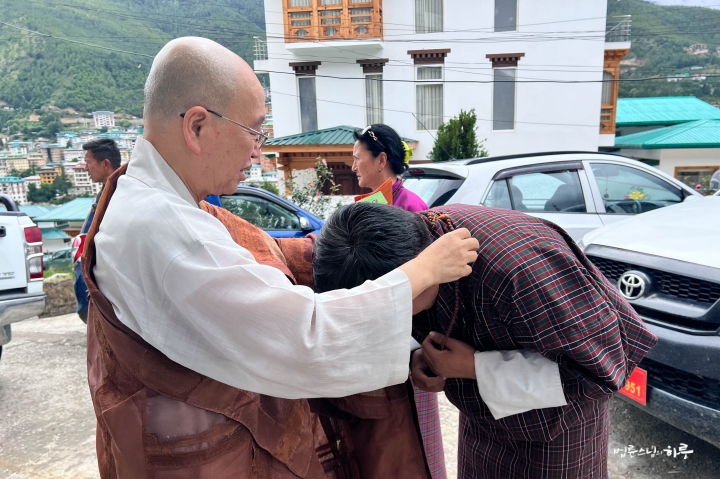
He presented Dr. Tashi with an English edition of “Revolutionary Buddha” and prayer beads as gifts.
After a short rest and unpacking, at 5 PM, they headed to the Cabinet Office to meet the Cabinet Minister. Today marked the signing of a Memorandum of Understanding (MOU) for three years of cooperation for Bhutan’s sustainable development. The Cabinet Minister and the Deputy Secretary of the Royal Secretariat were waiting for Sunim at the Cabinet Office.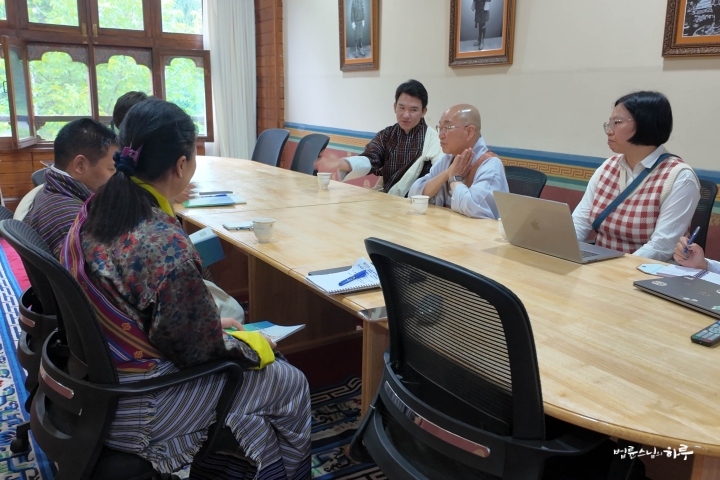
“Have you been well?”
“Yes, Sunim. Have you been well?”
“I spent 100 days giving Dharma talks in Korea. This time, I conducted workshops with the Gups and Tshogpas in Trongsa and Zhemgang respectively. I explained that this is not just a project but a ‘Buddhist service.’ The greatest Buddhist service in the world is saving sentient beings, so I proposed that we should put more effort into alleviating residents’ suffering than building temples or erecting Buddha statues. I gave prayer beads to participants and told them they were becoming bodhisattvas from today. While we couldn’t complete everything planned in the pilot project, we were able to get an overall understanding of how people work.”
“Are you satisfied with the pilot project results?”
“Yes. There were various difficulties, but we managed well. When the main project starts, I plan to have the annual budget disbursed at once so we can purchase materials in bulk at lower prices. The most needed items are roofing materials, cement, fence wire mesh, pipes, electrical wires, sinks, and toilets. Wood can be sourced from the village, as can gravel and sand. Tomorrow, I have a meeting scheduled with company representatives regarding materials.”
“We will also look into ways to purchase materials cheaply through our dzongkhag officials.”
Sunim and the Cabinet Minister then signed the Memorandum of Understanding. They agreed to cooperate over the next three years with $5 million to improve residents’ living conditions through new housing construction and repairs, water supply installation, fence construction, and road maintenance.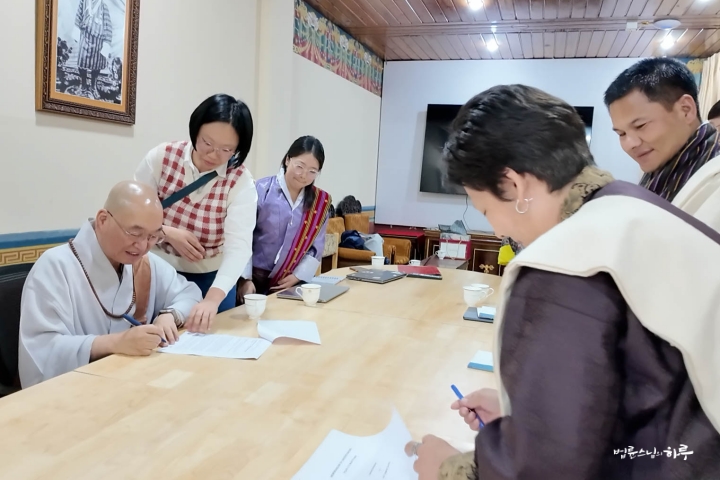
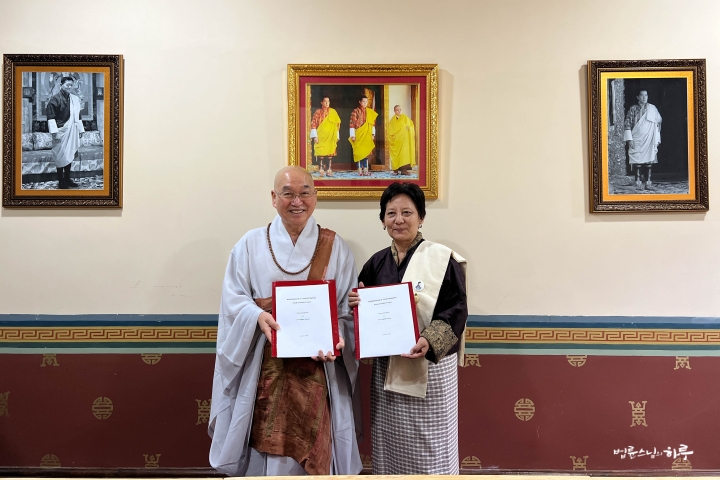
Sunim presented the English edition of “Revolutionary Buddha” and prayer beads from Bodh Gaya as gifts to both officials. While placing the prayer beads around their necks, Sunim said:
“From today, I appoint you as bodhisattvas!” (laughter)
“Yes, Sunim!” (laughter)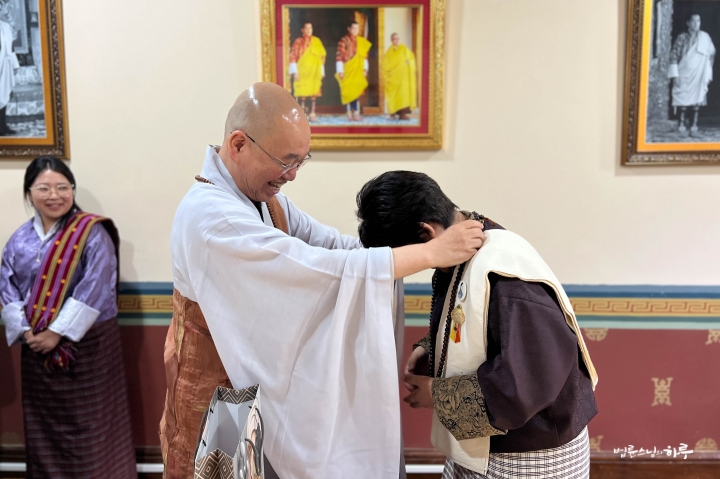
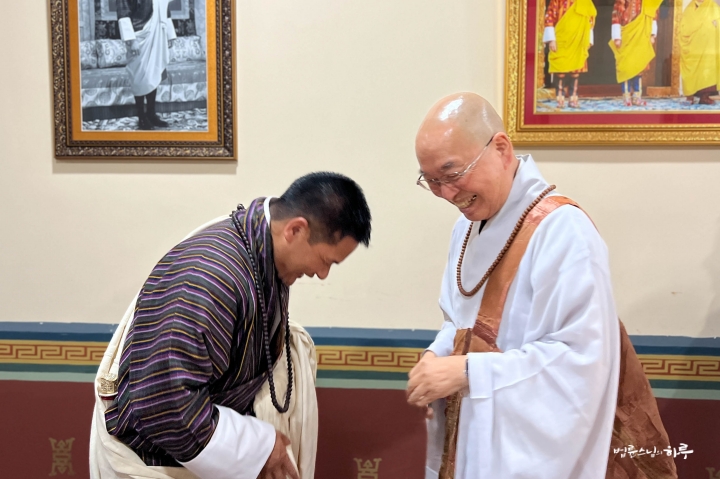
He also presented the English edition of “Revolutionary Buddha” to Yeshi, who had accompanied them throughout the past week’s schedule.
For dinner, they moved to a restaurant in downtown Thimphu, where they had a meal arranged by the Cabinet Office together with the Cabinet Minister and Deputy Secretary of the Royal Secretariat.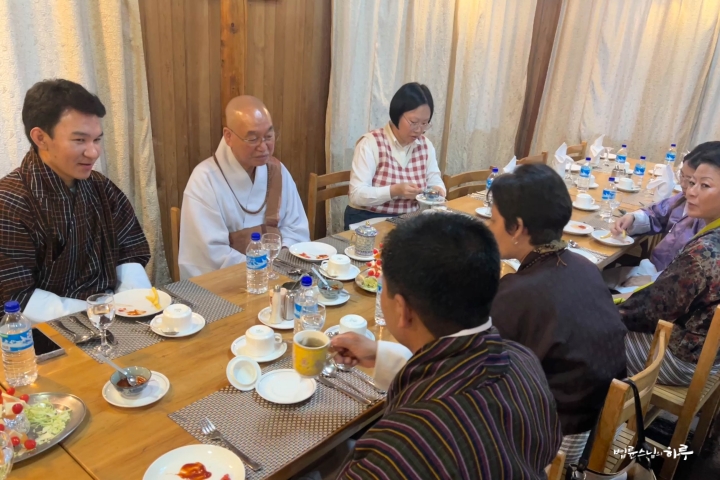
Returning to the accommodation at 8 PM, Sunim took a brief walk below the lodging in the cool evening breeze of Thimphu before going to his room to end the day.
Since there was no Dharma talk today, I’ll share a conversation between Sunim and a questioner from last week’s online Weekly Dharma Assembly conducted from Bhutan. As Jungto Society members are currently participating in the Semi-annual retreat for Jungto practitioners, I’ll share this Dharma Q&A, which I hope will support your retreat practice.
Feeling Lost About Setting Practice Goals
“The goal of practice is to become a person free from suffering. Everything encountered on the path toward that goal is practice and a practice goal. In traditional Buddhist terms, the goals of practice are called liberation and nirvana, and in modern terms, we can call them complete freedom or complete happiness.
However, we haven’t yet reached such a state. We’re still in suffering, bound by various constraints. We remain in negative mental states of anger, irritation, hatred, and resentment. Moving away from these minds toward a peaceful and tranquil state – not depressed or excited but calm – is the goal of practice.
Liberation and nirvana aren’t different concepts but concepts with one direction. To move in that direction, we reflect on our current state and continue practicing forward. With this perspective, when lonely, we can realize ‘Loneliness arises because I’m closing my heart’s door,’ when angry, ‘I’m insisting I’m right,’ and when feeling inadequate, ‘I want to be superior.’
Usually, when practicing for a specific period – whether 100 days, 49 days, or 21 days – we take our most pressing issue as the practice goal. For example, if these days just seeing your husband’s face makes you irritated and angry to the point you can’t bear it, this becomes your practice goal. Then you set a specific goal like ‘See my husband as Buddha’ or ‘Look at my husband with loving eyes.’ Whenever hateful feelings arise, you remind yourself, ‘No, my husband is Buddha’ or ‘Let me have loving feelings toward my husband,’ focusing on that goal. You temporarily set aside other issues and first concentrate on one object – your husband. For instance, if you have repeated impulses to buy things, you can recognize that desire and focus on one goal of ‘not buying things’ for a week, a month, or 100 days. These can become focused practice goals.
You don’t have to set a practice goal. Practice itself is about taking anger, irritation, hatred, and resentment as goals. The goal of practice is to reach a state free from suffering now, and everything causing suffering now can be a practice goal. Among these, if there’s a particularly significant problem for you now, that can become your practice goal. For example, if you’ve been continuously depressed and sad since your mother passed away, that emotion becomes your biggest challenge now. If you have no economic difficulties and no particular problems with your husband or children, but tears come whenever you think of your mother and everything feels meaningless, becoming free from your deceased mother becomes your practice goal. You make freeing yourself from that emotion your practice goal and practice with focus.
When doing 100-day prayer consistently every day, you can decide ‘For these 100 days, I’ll focus on this.’ For instance, if you tend to get angry easily, for these 100 days you can set specific practice goals like ‘I’ll become someone who doesn’t get angry’ or ‘I’ll do 108 prostrations whenever I get angry.’ If you feel you’re always stubborn or get angry easily, you can take this as a 3-year goal and practice steadily. Conversely, if you’re only slightly stubborn and occasionally get angry, you can make ‘not being stubborn’ the goal for these 100 days, and ‘not getting angry’ for the next 100 days, changing goals each period.
There’s no need to overthink or debate this matter. Even without setting a separate goal, practice itself already includes goals. Becoming a person without suffering, a free person, is itself the practice goal. It’s similar to when aiming for a healthy body, sometimes setting exercise goals like ‘building leg muscles,’ other times ‘losing belly fat,’ or ‘preventing colds.’ Not setting a practice goal doesn’t mean not practicing. Practice itself is already a goal, so you don’t need to set a separate one. Just as when exercising you might simply aim to ‘be healthy’ without setting specific goals.
However, if a doctor says ‘You’re mentally anxious, so you need lower body exercise. Do many prostrations or walk a lot,’ then while doing various exercises, setting ‘walking’ or ‘prostrations’ as goals for these 100 days and focusing on them can be a good method. Similarly with practice, you can set one goal, steadily work on one goal for 3 years, set new ones every 100 days, or specially set one just for the Semi-annual retreat period.”
“Thank you. Beyond having or not having practice goals, I was deeply touched by your words that since the goal of practice is a free and happy life, eliminating suffering itself is the practice goal.”





